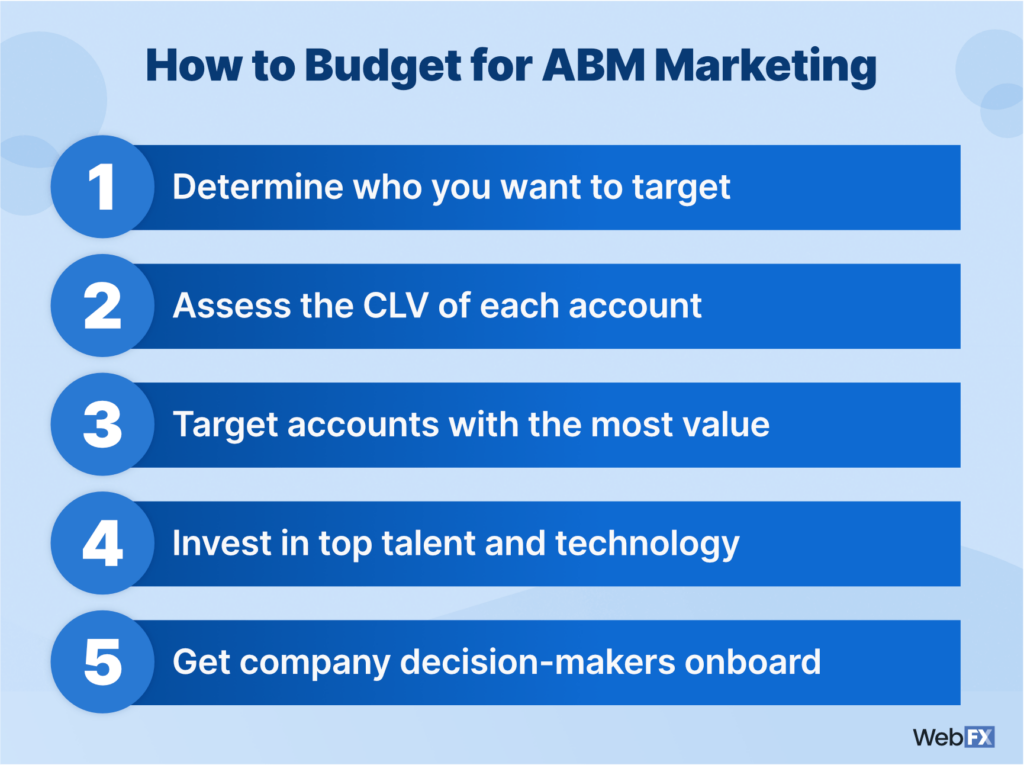2026 Account-Based Marketing Pricing: What Should Your Business Pay?
Transparent ABM Pricing
For Reaching High-Value Prospects
While PPC, social advertising, SEO and other digital marketing efforts are working to drive new traffic and leads— ABM maximizes the outcomes from that work by keeping your business top-of-mind.
Try ABM
Scale ABM

Enterprise

Level Up Your Paid Campaigns with ABM
If you’re considering PPC, or social media advertising, ABM can be a great extension to these services. If you’re considering programmatic advertising, consider a more targeted approach with WebFX ABM. Connect with a WebFX strategist to discuss the right paid advertising channels for your business!
Common ABM Marketing Pricing Questions
We improve the numbers that matter most
Read our case studies for more a more in-depth look at our results.
ABM Plans From WebFX
Learn more about how much account-based marketing costs by browsing our pricing plans below
| Features | Basic Current Clients Only | Aggressive Current Clients Only | Market Leader Current Clients Only |
|---|---|---|---|
| Initial Campaign Development and Strategy | |||
| LinkedIn Company Size, Industry, Job Title, Job Function, etc | |||
| LinkedIn Targeting of Existing Contact Lists (emails and phone numbers) | |||
| LinkedIn CompanyTrackerFX Site Visit Targeting | |||
| LinkedIn Wish-List Account Targeting | |||
| LinkedIn Site Visit LinkedIn Retargeting | |||
| Google Ads Retargeting of LinkedIn Company Visits (starts in month 3) | |||
| Google Ads Similar audience target development for those visiting your site through account-based targeting strategies | |||
| Google Ads Custom in-market segments developed for target industries | |||
| Google Ads Competitor Interest-Based Display Targeting | |||
| Bing Audience Targeting Professional User Profile Targeting | |||
| Lead Nuturing Strategy for Account-Based Marketing Leads | |||
| Creative Development for Ads and Long-Term SEO Account Targeting | |||
| Initial LinkedIn Sponsored Content Ads (up to 4) | |||
| Additional LinkedIn Ads | Additional One-Time Creative | Additional One-Time Creative | Additional One-Time Creative |
| LinkedIn Lead Form Ad Included | |||
| Initial Display Ad Development for Google Audience Targeting | |||
| Additional Display Ad Development (up to 4) (created every 6 months) | |||
| Google Analytics & RevenueCloudFX Integration & Goal Tracking | |||
| RevenueCloudFX Software Installation, Access, and Training | |||
| RevenueCloudFX Competitor Intelligence Monitoring | |||
| RevenueCloudFX Lead Tracking (Calls and Forms) | |||
| RevenueCloudFX CompanyTrackerFX Visit Reporting | |||
| Results analysis/reporting with Google Analytics and RevenueCloudFX for ROI | |||
| Ongoing Industry Analysis and Monthly Strategy Development | |||
| Ad Campaign Copywriting and Strategy Development | |||
| Single Account Representative | |||
| Personal Consultation Per Month | 1 Consultation | Up to 2 Consultations | Up to 4 Consultations |
| Up to 100 web lead phone calls tracked per month (Included for all WebFX clients) | |||
| *Additional call tracking over 100 calls | Custom Quote | Custom Quote | Custom Quote |
| Up to 25 web lead phone calls transcribed per month | |||
| Monitoring clicks, conversions and click fraud activity | |||
| Monthly performance & analysis reporting | |||
| 750+ SMEs behind campaign driving results | |||
| Initial ABM Campaign Investment (1-Month Duration) | $2,500 | $2,800 | +12% of ad spend |
| Ad Network Monthly Spend | $850 – $2,500 | $2,500 – $ 5,000 | $ 5,001+ |
| Progressive Monthly Management Cost (6-Month Commitment, Subsequent 5 Months) | $525 | $650 | $225/mo. +12% of ad spend |
| Need more information? Call Us: 888-601-5359 | GET STARTED | GET STARTED | GET STARTED |
Get custom account-based marketing pricing
Companies trust WebFX for account-based marketing.
With more than 29 years of experience, plus more than 750+ talented digital marketing specialists, we provide you with a custom strategy powered by machine learning and artificial intelligence. Plus, we offer transparent reporting and routine check-ins to keep your team up-to-date on your campaign.
Get a free quote for your marketing plan by contacting us online or calling us at 888-601-5359!














